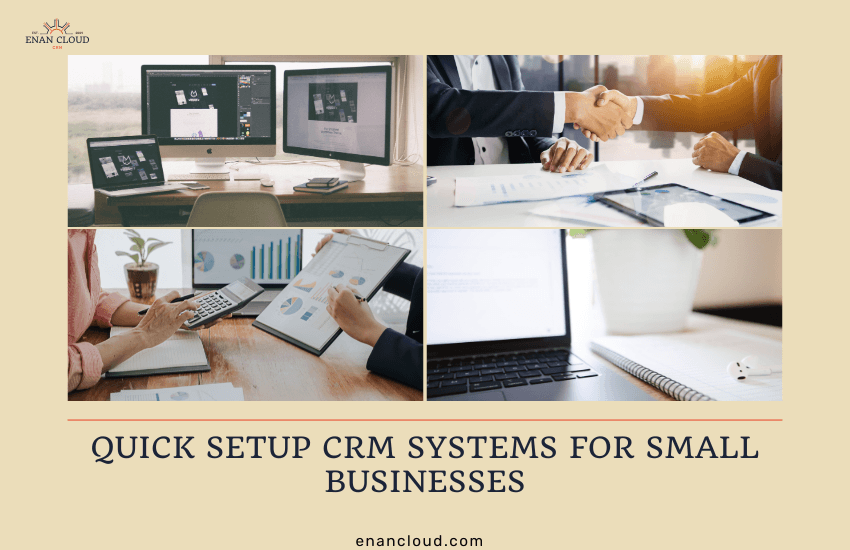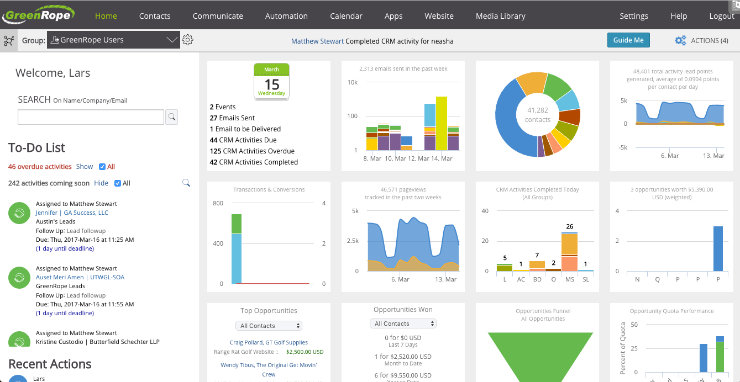
Small Business CRM Setup: Your Complete Guide to Customer Relationship Gold
So, you’re running a small business. Congratulations! You’re chasing dreams, building something from the ground up, and probably juggling a million different tasks. One of those tasks, perhaps looming large, is managing your customer relationships. That’s where a Customer Relationship Management (CRM) system comes in. Think of it as the central nervous system for your business, connecting all the vital organs (sales, marketing, customer service) and helping them work in harmony. This guide is your roadmap to setting up a CRM that works for your small business, transforming your customer interactions from chaotic to coordinated and ultimately, driving growth.
Why Your Small Business Needs a CRM
Let’s be honest, managing customer data in spreadsheets or email inboxes is a recipe for disaster. Information gets lost, leads fall through the cracks, and opportunities are missed. A CRM solves these problems and offers a wealth of benefits. Here’s why a CRM is not just a ‘nice-to-have’ but a ‘must-have’ for your small business:
- Centralized Customer Data: Say goodbye to scattered information! A CRM stores all your customer interactions, contact details, purchase history, and more in one accessible place.
- Improved Organization and Efficiency: Automate tasks, streamline workflows, and save valuable time. No more manual data entry or endless searching for information.
- Enhanced Customer Experience: With a 360-degree view of your customers, you can personalize interactions, anticipate their needs, and provide exceptional service.
- Increased Sales: Track leads, manage the sales pipeline, and close deals more effectively. CRM helps you identify and capitalize on sales opportunities.
- Better Marketing ROI: Segment your audience, target your marketing efforts, and measure the results of your campaigns.
- Improved Team Collaboration: Share customer information and collaborate seamlessly, ensuring everyone is on the same page.
- Data-Driven Decisions: Get valuable insights into your customers and business performance, enabling you to make informed decisions.
Choosing the Right CRM for Your Small Business
The CRM market is vast and varied. Choosing the right one can feel overwhelming, but it doesn’t have to be. The key is to focus on your specific needs and budget. Here’s a breakdown of factors to consider:
1. Define Your Needs and Goals
Before you start comparing CRM systems, take a step back and assess your business requirements. What are your primary goals for implementing a CRM? What are your biggest pain points in managing customer relationships? Consider these questions:
- What are your key business processes? (e.g., sales, marketing, customer service)
- What data do you need to track about your customers? (e.g., contact information, purchase history, interactions)
- What features are essential for your business? (e.g., lead management, sales pipeline, email marketing integration)
- How many users will need access to the CRM?
- What is your budget?
Answering these questions will help you narrow down your options and choose a CRM that aligns with your business objectives.
2. Consider CRM Features
Different CRM systems offer a range of features. Evaluate the features that are most important to your business. Here are some common CRM features to consider:
- Contact Management: Store and manage customer contact information, including names, addresses, phone numbers, and email addresses.
- Lead Management: Track leads, qualify them, and nurture them through the sales pipeline.
- Sales Pipeline Management: Visualize your sales process, track deals, and forecast revenue.
- Email Marketing Integration: Integrate with email marketing platforms to send targeted campaigns and track results.
- Marketing Automation: Automate marketing tasks, such as sending emails, nurturing leads, and scoring leads.
- Customer Service and Support: Manage customer inquiries, track issues, and provide support.
- Reporting and Analytics: Generate reports and analyze data to gain insights into your business performance.
- Mobile Access: Access your CRM data on the go with mobile apps.
- Integrations: Integrate with other business tools, such as accounting software, e-commerce platforms, and social media.
3. Evaluate CRM Pricing and Plans
CRM systems offer various pricing models, including:
- Free Plans: Some CRM providers offer free plans with limited features and user capacity. These can be a good option for very small businesses or startups.
- Subscription-Based Plans: Most CRM systems use a subscription-based model, with pricing based on the number of users, features, and storage space.
- Per-User Pricing: You pay a monthly or annual fee for each user who accesses the CRM.
- Tiered Pricing: CRM providers often offer different pricing tiers with varying features and user limits.
Consider your budget and the features you need when evaluating pricing plans. Don’t overspend on features you won’t use.
4. Research CRM Providers
Once you have a clear understanding of your needs and budget, it’s time to research CRM providers. Consider these factors:
- Ease of Use: Choose a CRM that is easy to learn and use.
- Scalability: Make sure the CRM can grow with your business.
- Customer Support: Look for a provider that offers reliable customer support.
- Reviews and Ratings: Read online reviews and ratings to get feedback from other users.
- Security: Ensure the CRM provider has robust security measures to protect your data.
Some popular CRM providers for small businesses include:
- HubSpot CRM: A free, user-friendly CRM with a wide range of features.
- Zoho CRM: A feature-rich CRM with affordable pricing plans.
- Salesforce Sales Cloud: A powerful CRM with a comprehensive set of features, suitable for growing businesses.
- Pipedrive: A sales-focused CRM that is easy to use and ideal for small sales teams.
- Freshsales: A CRM designed for sales teams with features like built-in phone and email.
5. Trial and Demo
Before making a final decision, take advantage of free trials and demos offered by CRM providers. This will allow you to test the system, explore its features, and see if it meets your needs. Don’t be afraid to ask questions and get hands-on experience with the CRM before committing.
Setting Up Your Small Business CRM: A Step-by-Step Guide
Once you’ve chosen your CRM, the real fun begins: setting it up! This process can seem daunting, but breaking it down into manageable steps makes it much more achievable. Here’s a step-by-step guide to get you started:
Step 1: Account Creation and Initial Setup
Sign Up: Go to the CRM provider’s website and create an account. You’ll typically need to provide your email address, business name, and other basic information.
Choose Your Plan: Select the pricing plan that aligns with your business needs and budget. Review the features included in each plan and choose the one that fits best.
Customize Your Profile: Fill out your profile information, including your company logo, contact details, and other relevant information. This helps personalize your CRM experience.
Step 2: Data Import and Organization
Import Your Data: This is a crucial step. Gather your existing customer data from spreadsheets, email contacts, and other sources. Most CRM systems allow you to import data in CSV (Comma Separated Values) format. Follow these steps:
- Prepare Your Data: Clean and organize your data in a CSV file. Make sure your data is consistent and well-formatted. Include fields like name, email, phone number, company, and any other relevant information.
- Import the CSV File: In your CRM, navigate to the data import section. Follow the instructions to upload your CSV file.
- Map Your Fields: Match the columns in your CSV file to the corresponding fields in your CRM. This ensures that your data is imported correctly.
- Review and Clean Up: After importing, review your data for any errors or inconsistencies. Clean up your data to ensure accuracy.
Organize Your Data: Once your data is imported, organize it within the CRM. Create custom fields, tags, and categories to segment your customers and track important information.
Step 3: Configure Your CRM Settings
User Management: Add users to your CRM and assign roles and permissions. This controls who can access and modify data within the system.
Customize Fields: Create custom fields to track specific information relevant to your business, such as industry, lead source, or product interests.
Set Up Workflows and Automation: Automate repetitive tasks to save time and improve efficiency. For example, you can set up automated email responses, lead nurturing sequences, and task assignments.
Integrate with Other Tools: Connect your CRM with other business tools, such as email marketing platforms, accounting software, and social media channels. This streamlines your workflows and eliminates the need for manual data entry.
Step 4: Sales Pipeline and Lead Management
Define Your Sales Stages: Customize your sales pipeline to reflect your sales process. Define the stages your leads go through, such as prospecting, qualification, proposal, negotiation, and closed won/lost.
Create Lead Capture Forms: Integrate lead capture forms on your website and landing pages to automatically capture lead information and add it to your CRM. This helps you generate leads and nurture them through the sales pipeline.
Set Up Lead Scoring: Assign points to leads based on their behavior and engagement. This helps you prioritize your sales efforts and focus on the most qualified leads.
Automate Sales Tasks: Automate sales tasks, such as sending follow-up emails, scheduling calls, and creating tasks. This saves your sales team time and helps them stay organized.
Step 5: Marketing Automation and Email Integration
Connect Your Email Marketing Platform: Integrate your CRM with your email marketing platform to send targeted campaigns, track email performance, and nurture leads.
Segment Your Audience: Segment your audience based on their interests, behaviors, and demographics. This allows you to send personalized emails and improve your marketing ROI.
Create Automated Email Sequences: Create automated email sequences to nurture leads, onboard new customers, and send promotional offers. This helps you engage with your audience and drive conversions.
Track Email Performance: Track email open rates, click-through rates, and conversion rates to measure the effectiveness of your email marketing campaigns.
Step 6: Training and Adoption
Train Your Team: Provide training to your team on how to use the CRM effectively. Explain the features, functionalities, and best practices for using the system.
Create User Guides and Documentation: Develop user guides and documentation to help your team use the CRM. This ensures that everyone understands how to use the system and can access the information they need.
Encourage Adoption: Encourage your team to use the CRM regularly. Highlight the benefits of using the system and provide ongoing support and encouragement.
Provide Ongoing Support: Offer ongoing support to your team to help them with any questions or issues they encounter. This ensures that they can use the CRM effectively and get the most out of the system.
Step 7: Ongoing Maintenance and Optimization
Regular Data Updates: Keep your CRM data up-to-date by regularly cleaning and updating your customer information. This ensures that your data is accurate and reliable.
Analyze Data and Generate Reports: Regularly analyze your CRM data to gain insights into your business performance. Generate reports to track key metrics, such as sales, leads, and customer engagement.
Refine Workflows and Automations: Continuously refine your workflows and automations to improve efficiency and optimize your processes. This ensures that your CRM is working effectively for your business.
Stay Updated: Stay up-to-date with the latest CRM features and updates. This ensures that you are using the most current version of the system and can take advantage of new features.
Tips for CRM Success
Setting up a CRM is a significant step, but it’s only the beginning. Here are some tips to help you achieve CRM success:
- Get Buy-In from Your Team: Make sure your team understands the benefits of using a CRM and is committed to using it.
- Start Small and Scale Up: Don’t try to implement every feature at once. Start with the core features and gradually add more as you become more comfortable.
- Focus on Data Quality: Accurate data is essential for CRM success. Regularly clean and update your data to ensure its accuracy.
- Use the CRM Consistently: Encourage your team to use the CRM consistently. This ensures that you are capturing all the necessary data and maximizing the benefits of the system.
- Monitor Your Progress: Track key metrics, such as sales, leads, and customer engagement, to measure the effectiveness of your CRM.
- Be Patient: It takes time to fully implement a CRM and see results. Be patient and persistent, and you will eventually reap the rewards.
- Integrate with Other Tools: Integrate your CRM with other business tools to streamline your workflows and eliminate the need for manual data entry.
- Provide Regular Training: Provide regular training to your team to ensure that they are comfortable using the CRM and can use it effectively.
- Seek Expert Advice: If you need help, don’t hesitate to seek expert advice from a CRM consultant or provider.
Common CRM Mistakes to Avoid
Even with the best intentions, small businesses can stumble during CRM implementation. Avoiding these common pitfalls can significantly increase your chances of success:
- Choosing the Wrong CRM: Select a CRM that doesn’t fit your business needs. Spend time researching and evaluating options before making a decision.
- Insufficient Planning: Failing to define your goals, processes, and requirements before implementation.
- Poor Data Migration: Importing inaccurate or incomplete data, leading to data quality issues.
- Lack of Training: Not providing adequate training to your team, resulting in low adoption rates.
- Ignoring Team Input: Failing to involve your team in the CRM selection and implementation process.
- Overcomplicating the Setup: Trying to implement too many features at once or customizing the system excessively.
- Not Integrating with Other Tools: Failing to integrate the CRM with other business tools, leading to data silos and inefficiency.
- Neglecting Data Quality: Not regularly cleaning and updating your data, leading to inaccurate insights.
- Lack of Ongoing Support: Not providing ongoing support to your team, leading to frustration and low adoption rates.
The Future of CRM for Small Businesses
The CRM landscape is constantly evolving, and small businesses can expect even more powerful and user-friendly tools in the future. Here are some trends to watch:
- Artificial Intelligence (AI): AI-powered CRM systems will automate tasks, provide predictive analytics, and personalize customer interactions.
- Mobile CRM: Mobile CRM apps will become even more sophisticated, providing real-time access to data and enabling sales teams to work from anywhere.
- Integration with Social Media: CRM systems will integrate more seamlessly with social media platforms, allowing businesses to monitor social conversations, engage with customers, and manage their social media presence.
- Focus on Customer Experience: CRM systems will increasingly focus on delivering exceptional customer experiences, with features that personalize interactions and anticipate customer needs.
- Increased Automation: CRM systems will automate more tasks, such as email marketing, lead nurturing, and customer service, freeing up time for businesses to focus on other priorities.
Conclusion: Embrace the Power of CRM
Setting up a CRM for your small business is an investment in your future. It’s about building stronger customer relationships, streamlining your operations, and driving sustainable growth. By following this guide, you can choose the right CRM, set it up effectively, and empower your team to achieve CRM success. Don’t be afraid to take the plunge – the benefits are well worth the effort. Embrace the power of CRM and watch your small business thrive!


